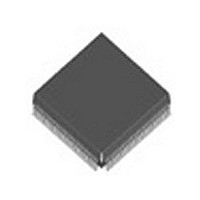HBLXT9761HC.C4 Intel, HBLXT9761HC.C4 Datasheet - Page 30

HBLXT9761HC.C4
Manufacturer Part Number
HBLXT9761HC.C4
Description
Manufacturer
Intel
Datasheet
1.HBLXT9761HC.C4.pdf
(78 pages)
Specifications of HBLXT9761HC.C4
Lead Free Status / RoHS Status
Not Compliant
- Current page: 30 of 78
- Download datasheet (2Mb)
LXT9761/9781 — Fast Ethernet 10/100 Multi-Port Transceiver with RMII
2.5.2
2.6
30
Figure 12. Auto-Negotiation Operation
Note: Do not enable Auto-Negotiation if fiber mode is selected.
Auto-Negotiation
Go To Forced
Disable
Settings
Parallel Detection
In parallel with auto-negotiation, the LXT97x1 also monitors for 10 Mbps Normal Link Pulses
(NLP) or 100 Mbps Idle symbols. If either is detected, the device automatically reverts to the
corresponding operating mode. Parallel detection allows the LXT97x1 to communicate with
devices that do not support auto-negotiation.
RMII Operation
The LXT97x1 provides an independent Reduced MII port for each network port. Each RMII uses
four signals to pass received data to the MAC: RXDn<1:0>, RXERn, and CRS_DVn (where n
reflects the port number). Three signals are used to transmit data from the MAC: TXDn_<1:0>,
and TXENn. Both Receive and transmit signals are clocked by REFCLK. Data transmission
across the RMII is implemented in di-bit pairs which equal a 4-bit-wide nibble.
Done
•
•
•
After power-up, power-down, or reset, the power-down recovery time, (see
page
Set the auto-negotiation advertisement bits.
Enable auto-negotiation (set MDIO bit 0.12 = 1).
61), must be exhausted before proceeding.
0.12 = 0
Power-Up, Reset,
Link Failure
Check Value
Attempt Auto-
Start
0.12
Negotiation
0.12 = 1
YES
Listen for 100TX
Auto-Neg/Parallel Detection
Idle Symbols
Link Set
Enable
NO
Listen for 10T
Link Pulses
Table 31 on
Datasheet
Related parts for HBLXT9761HC.C4
Image
Part Number
Description
Manufacturer
Datasheet
Request
R

Part Number:
Description:
Microprocessor: Intel Celeron M Processor 320 and Ultra Low Voltage Intel Celeron M Processor at 600MHz
Manufacturer:
Intel Corporation

Part Number:
Description:
Intel 82550 Fast Ethernet Multifunction PCI/CardBus Controller
Manufacturer:
Intel Corporation
Datasheet:

Part Number:
Description:
Intel StrataFlash memory 32 Mbit. Access speed 120 ns
Manufacturer:
Intel Corporation
Datasheet:

Part Number:
Description:
Intel StrataFlash memory 32 Mbit. Access speed 120 ns
Manufacturer:
Intel Corporation
Datasheet:

Part Number:
Description:
Intel StrataFlash memory 64 Mbit. Access speed 150 ns
Manufacturer:
Intel Corporation
Datasheet:

Part Number:
Description:
Intel StrataFlash memory 32 Mbit. Access speed 100 ns
Manufacturer:
Intel Corporation
Datasheet:

Part Number:
Description:
DA28F640J5A-1505 Volt Intel StrataFlash Memory
Manufacturer:
Intel Corporation
Datasheet:

Part Number:
Description:
5 Volt Intel StrataFlash?? Memory
Manufacturer:
Intel Corporation
Datasheet:

Part Number:
Description:
5 Volt Intel StrataFlash?? Memory
Manufacturer:
Intel Corporation

Part Number:
Description:
Intel 6300ESB I/O Controller Hub
Manufacturer:
Intel Corporation
Datasheet:

Part Number:
Description:
Intel 82801DB I/O Controller Hub (ICH4), Pb-Free SLI
Manufacturer:
Intel Corporation
Datasheet:

Part Number:
Description:
Intel 82801FB I/O Controller Hub (ICH6)
Manufacturer:
Intel Corporation
Datasheet:

Part Number:
Description:
Intel Strataflash Memory28F128J3 28F640J3 28F320J3
Manufacturer:
Intel Corporation
Datasheet:

Part Number:
Description:
Controllers, Intel 430TX PCIset: 82439TX System Controller (MTXC)
Manufacturer:
Intel Corporation










